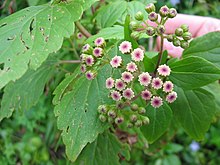Ageratina
| Ageratina | |
|---|---|

| |
| Sticky Snakeroot (Ageratina adenophora) | |
| Scientific classification | |
| Kingdom: | |
| (unranked): | |
| (unranked): | |
| (unranked): | |
| Order: | |
| Family: | |
| Subfamily: | |
| Tribe: | |
| Genus: | Ageratina |
| Species | |
|
About 250, see text | |
Ageratina (snakeroot) is a genus of more than 330[1][2][3][4] perennials and rounded shrubs in the family Asteraceae.
These plants grow mainly in the warmer regions of the Americas and West Indies. Over 150 species are native to Mexico.[5] Some flourish in the cooler areas of the eastern United States. Two Mexican species have become a pest in parts of Australia and Taiwan.[4] Ageratina used to belong to the genus Eupatorium, but it has been reclassified.
Description
The inflorescence consists of multiple fluffy, red or pinkish-white capitula in clusters. These lack the typical ray flowers of the composites.
They have multiple, much-branched woody stems. The petioles are rather long. The leaves are triangular, serrate and opposite with a foul-smelling, musky scent.
Species
Toxicity
Milk from cows that have eaten snakeroot can cause illness if ingested because the milk becomes toxic. Symptoms of milk sickness include vomiting.
Medicinal Use
Ageratina pichinchensis is a traditional Mexican treatment for superficial fungal infections of the skin. These plant extracts contain encecalin which has activity to inhibit and kill the fungus. Studies have compared its effectiveness in treating toenail fungus with ciclopirox.[7][8][9]
Notes
- ^ "Ageratina". The Plant List. Version 1.1. 2013. Retrieved 2016-09-19.
- ^ "Ageratina". Flora of North America.
- ^ Carmen Ulloa Ulloa and Peter Møller Jørgensen. "Ageratina Spach". Arboles y arbustos de los Andes del Ecuador (Trees and shrubs of the Andes of Ecuador).
- ^ a b "Ageratina Spach". Flora of Taiwan.
- ^ a b c d e Turner, B. L. (2010). Four new species of Ageratina (Asteraceae): Eupatorieae) from Oaxaca, Mexico. Archived July 27, 2011, at the Wayback Machine Phytologia 92:3 388-99.
- ^ Turner, B. L. (2010). Ageratina villarrealii (Asteraceae: Eupatorieae), A new species from Sierra de Zapaliname, Coahuila, Mexico Archived July 27, 2011, at the Wayback Machine Phytologia 92:3 362-65.
- ^ Snakeroot leaf extract, proven as toenail fungus natural treatment
- ^ Romero-Cerecero, Ofelia; Román-Ramos, Rubén; Zamilpa, Alejandro; Jiménez-Ferrer, Jesús Enrique; Rojas-Bribiesca, Gabriela; Tortoriello, Jaime (2009). "Clinical trial to compare the effectiveness of two concentrations of the Ageratina pichinchensis extract in the topical treatment of onychomycosis". Journal of Ethnopharmacology. 126 (1): 74–78. doi:10.1016/j.jep.2009.08.007. PMID 19683043.
{{cite journal}}: CS1 maint: postscript (link) - ^ Romero-Cerecero, Ofelia; Zamilpa, Alejandro; Jiménez-Ferrer, Jesús; Rojas-Bribiesca, Gabriela; Román-Ramos, Rubén; Tortoriello, Jaime (2008). "Double-Blind Clinical Trial for Evaluating the Effectiveness and Tolerability ofAgeratina pichinchensisExtract on Patients with Mild to Moderate Onychomycosis. A Comparative Study with Ciclopirox". Planta Medica. 74 (12): 1430–1435. doi:10.1055/s-2008-1081338. PMID 18671197.
{{cite journal}}: CS1 maint: postscript (link)
Long used in India to treat snakebite, epilepsy, mental disorders. It was also discovered to be useful in regulating hypertension discovered in 1949, but it causes various side effects. Used to treat schizophrenia due to the alkaloid reserpine it contains.
External links
![]() Media related to Ageratina at Wikimedia Commons
Media related to Ageratina at Wikimedia Commons
![]() Data related to Ageratina at Wikispecies
Data related to Ageratina at Wikispecies
